Our view at Stack - Pipedrive is a robust CRM platform, offering automation, contact data collection, webhooks, AI-powered sales assistant, email communications, email marketing, and customisable sales pipeline workflows.
While you may be unable to read your customer’s minds or predict with certainty how your next product launch will go, a market research report can get you close.
Clear and documented market analysis helps you get inside your customers’ heads, understand broader market trends and make accurate predictions about future business decisions.
In this article, you’ll learn how to write and use a market research report for your small business, what every good report should include and how you can leverage CRM data to expedite the report creation process.
What is a market research report?
A market research report documents findings and analyses of your business’s target audience and the broader market. It helps you understand your target audience, what they value and how wider macro-economic trends may impact their opinions and buying habits.
There is no prescribed format for reports. You can tailor your write-up to your audience’s needs and preferences, so a PDF, slide show or spreadsheet are all suitable mediums.
While reports can be as broad or as specific as necessary, most brands undertake market research to achieve a pre-defined goal such as assessing the viability of a new market or product.
Suppose you want to know whether a potential new product is feasible for mid-market B2B businesses. Customer surveys, group focus sessions and additional secondary research, such as market insights, can be potent combinations.
You could then use your CRM to identify relevant customer segments to survey and compile your findings into a market research report to share with stakeholders.
Your report will help them take the appropriate next steps, whether it’s proceeding with product development, commissioning further research or putting plans on hold.
Market research report vs. marketing research reports
Market research reports and marketing research reports sound synonymous, but it’s important to understand how they differ.
Market research reports are internal reports that analyze your market and customers. Anyone in your business can use them to make data-driven decisions about current and future strategies.
For example, marketing teams can consult your market research report when brainstorming creative routes. Product teams can refer to it when designing new software features.
On the other hand, marketing research reports are external-facing documents brands use to garner attention from their target market and win new business. These are also called white papers.
For instance, Pipedrive regularly publishes trend reports for marketing purposes, like The State of Sales and Marketing 2023/24.

Meanwhile, McKinsey & Company releases market research reports regularly to aid companies in their decision-making. Below, its analysis of MSMEs (micro-, small- and medium-size enterprises) and various case studies shed light on the potential of small businesses worldwide:
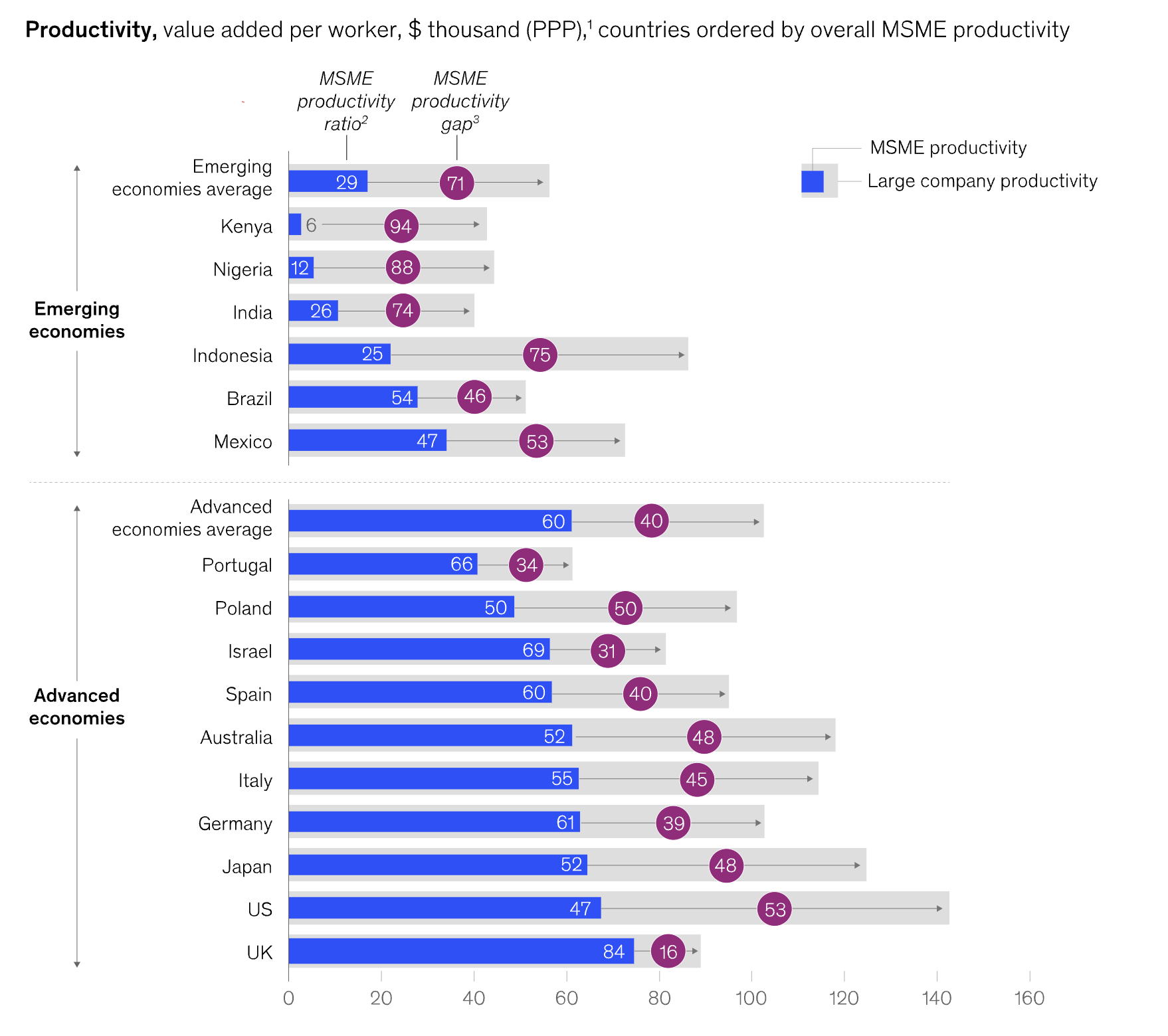
It can be confusing to distinguish between the two report types since both involve conducting research.
To help clarify, the table below lists the key differences between market research reports and marketing research reports:
| Market research report | Marketing research report |
Now you know what a marketing research report involves, see why you’d want to spend time and money to create one for your small business.
Recommended reading

Marketing reporting: how to create reports that inform decisions
4 benefits of creating a market research report
Industry experience is invaluable when making critical business decisions. Industry insights are even more powerful when paired with data-backed research on your market and competitors.
Making calculated strategic decisions becomes much easier with an in-depth market research report that provides the following benefits.
1. Understand the business landscape
Broad market research reports can give you a holistic view of the market. Information like market size, brand awareness, consumer attitudes and economic factors such as purchasing power keeps you abreast of the latest industry trends.
A clear understanding of the business landscape can also lift the lid on your competitors’ strategies and consumer attitudes toward them, helping you gain a competitive advantage.
For instance, a research report shows consumers are unhappy about a competitor’s recent price rise. You could use this information to evaluate your pricing strategy and develop a marketing campaign that targets this customer pain point.
2. Know what your audience thinks
A market research report can tell you much about your target market, including their goals, pain points and attitudes toward products and brands.
You can use this research to create accurate and deep buyer personas that let your sales team find and prioritize ideal prospects. It can also inform future product lines or marketing strategies so they better align with the market’s current needs.
3. Improve your messaging
If your creative team has a new campaign idea, a market research report can evaluate how much it will appeal to customers.
Using market research, you can test specific creative approaches. You can also gather a swipe file of opinions and pain points to ensure future campaigns resonate with your target audience and compel it to take action.
4. Uncover new business opportunities
It’s easier to brainstorm products that fill a gap in the market when you know what your customers think, want and need.
If you already have a new venture or small business idea in mind, market research can uncover whether there’s a genuine demand for your new product or service. You can gauge market size, potential price points, economic considerations and more.
Research methods: primary vs. secondary
You can collect two kinds of market research for your report: primary and secondary.
Primary research
Primary research is any data you collect to achieve your market research objective. It’s new, up to date and unique to you – ideal for guiding real-time decisions.
Primary research data can be expensive and time-consuming to collect and analyze. While it’s easy to download a finished report (secondary research) from an online database, organizing a dozen focus groups and collating the results will entail more work.
Some of the most common primary research methods include:
-
Face-to-face interviews
-
Focus groups
-
Surveys
These methods can be broad and exploratory, such as uncovering general consumer attitudes. Alternatively, they can be specific, drilling down to learn what your audience thinks about a product, competitor or ad creative.
Who you approach for research will depend on your goals, but existing customers will likely be willing and approachable targets.
Your CRM is an excellent place to find your customers’ details. Records can also highlight which customers engage with your team the most. These are the people you’ll want to contact first.
Recommended reading
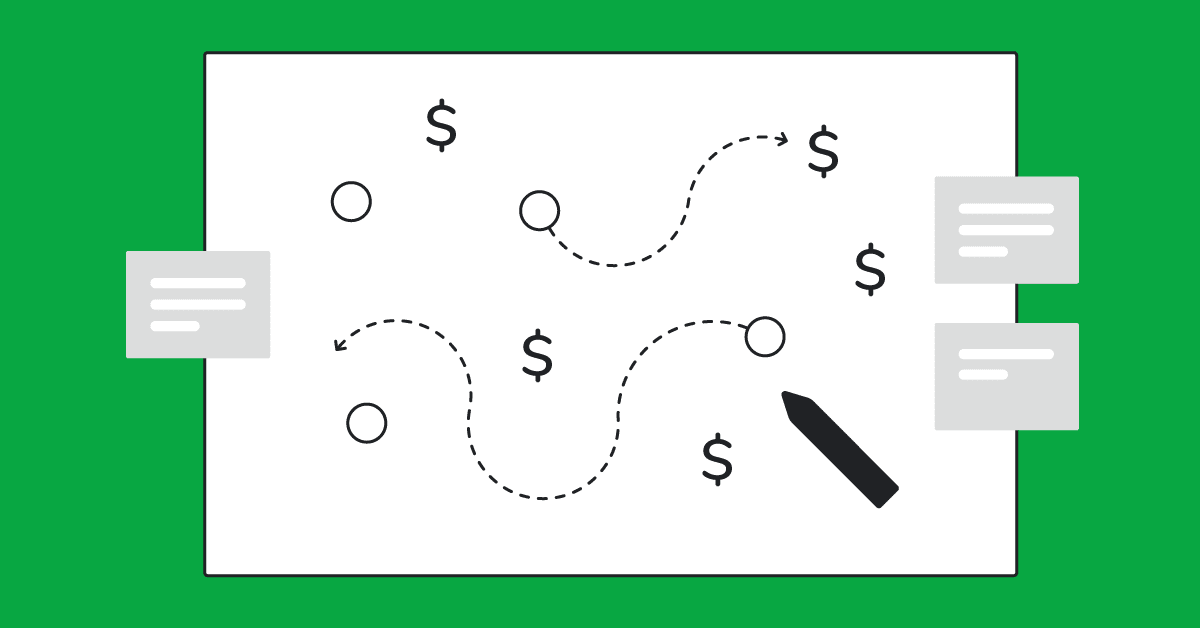
How to Convince Your Team to Invest in a CRM
Secondary research
Secondary research is any data your company, governments or other businesses have compiled. While this research can be easier to obtain (since you don’t have to host a focus group or send out a questionnaire), it’s not as specific to your business or industry as primary research.
Many free secondary data resources exist, including the United States Census Bureau, YouGov and Data.gov.
Research companies like the Pew Research Center, Forrester and Gartner offer free and premium market data and research materials, including industry forecasts and economic benchmarks. The latter can be expensive for small business owners, with subscriptions costing over five figures.
You don’t have to turn to external sources for secondary research. Your business’s CRM system often contains ample data that can reveal much about your customers’ preferences and buying habits.
For example, you can run Pipedrive reports to determine:
-
Which customer segments have the highest lifetime value
-
Which products customers typically buy together (or one after the other)
-
Whether certain buyer personas favor a particular product or service
Observing your customers is critical to understanding your target market’s behavior and then using that knowledge to grow your small business accordingly.
6 steps to create a market research report
A detailed report makes your market research useful and actionable. Ensure you cover all applicable points and deliver a high-impact document by following the steps below.
Step 1: pick an objective
First, define the purpose of your market research industry report. Example objectives include:
-
Testing a new product
-
Understanding a market segment
-
Identifying industry trends
-
Running a competitor or market analysis
-
Examining customer satisfaction levels
Think about who will read your market research report so you can plan ahead to meet their needs. Different audiences require different styles, tones and information.
You’ll also need to decide whether your market research report will be exploratory or specific. Exploratory research requires longer, more meandering interviews and may make it more difficult to provide actionable takeaways.
Tips for choosing an objective for your market research report:
-
Align your objective with your business goals (e.g., is the purpose to launch a new product or strength-test an existing service in a fluctuating market?)
-
Ensure your objective is measurable (i.e., what metrics will you use to define success?)
-
Set general and specific objectives (e.g., general: learn whether adding AI to your tool will increase user sign-ups; specific: learn how much of segment A uses AI in non-competitive productivity tools)
Step 2: define your research subjects and data collection methods
Market research is time- and resource-intensive, so know who you’ll be speaking to and what you need to learn before you begin.
Buyer personas are an excellent place to start – especially if your objective is to determine what a particular customer segment thinks about a product or idea.
If you don’t already have well-defined personas, use Pipedrive’s buyer persona templates to create your own using sales and demographic data from your CRM.
Better understand your customers with our Buyer Persona Templates
Use these templates to ensure your solution always aligns with your customers’ interests and needs
For industry analysis or competitive analysis, make a list of your competitors. These include product and category competitors (think Adidas vs. Nike) and search competitors (brands who rank for the same keywords in Google).
Tips to define your audience and data collection methods:
-
Use your CRM to identify customers belonging to target segments and message them in advance
-
Look for customers who recently interacted with your team as these will often be the best research candidates
-
Run a SWOT analysis of competing brands before you start to identify threats and opportunities you can explore with respondents
Step 3: collect data using one or more of the above methods
Undertake the research stage of your report using one or more of the above methods.
Try to include one piece of primary, custom research – if your budget allows – to acquire a unique viewpoint that’s not accessible to competitors.
Aim to collect both qualitative and quantitative results, too. The latter provides empirical evidence, while the former adds color and depth to your findings.
For example, asking customers to rank brands on a scale of one to 10 is a form of quantitative research. Questioning them about what they think about the brands is qualitative research.
Tips for collecting market research:
-
Align your research methodology with your objectives. Broad exploratory discussions are better in a group session. One-to-one interviews tend to be preferable for researching specific questions.
-
Spend time fine-tuning questions before you begin. The quality of your questions will determine the quality of your results, so use open-ended questions that respondents can’t answer with a yes or no.
-
If you use a market research agency, you can elicit more honest feedback by keeping your brand secret from respondents
Step 4: analyze the research
Turn raw data into clear and actionable insights by centralizing it in a spreadsheet or your favorite presentation tool. Then look for themes and commonalities between data sets.
Depending on your objectives, there may be frameworks that accelerate this process – such as SWOT analysis.
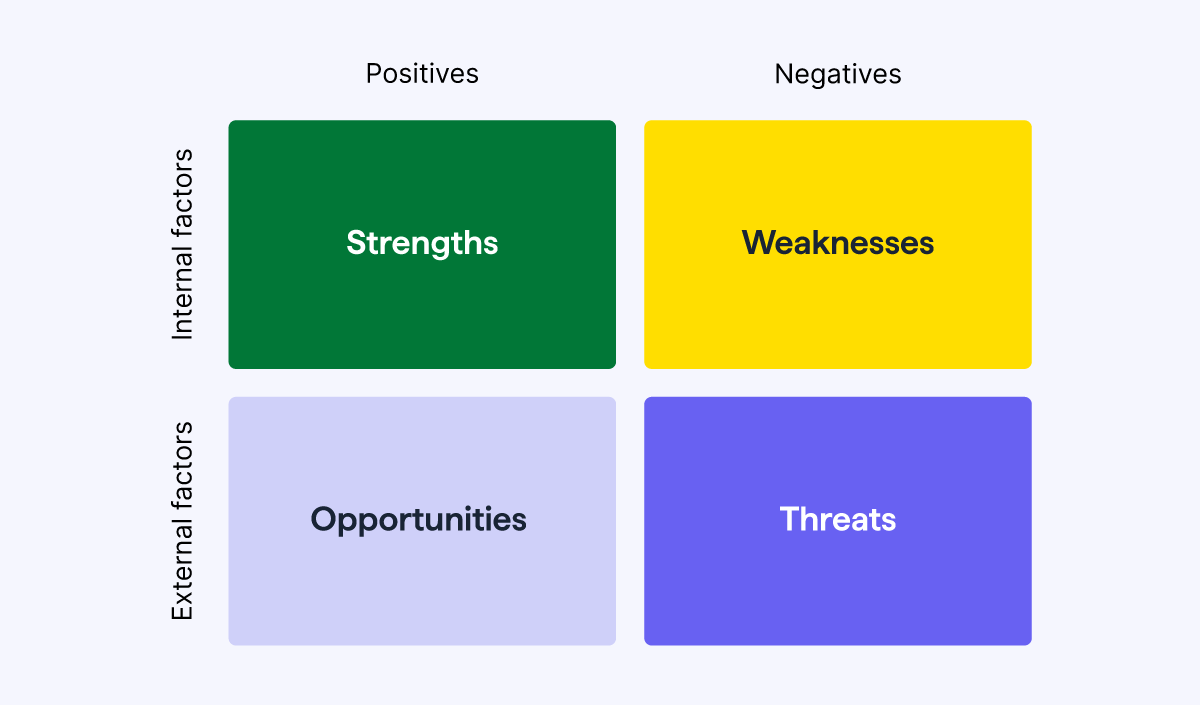
You can use a SWOT analysis framework to analyze the competitor and product research you’ve compiled for your small business reporting.
Tips to analyze market research:
-
Several common programs are suitable for collating research, like PowerPoint and Excel. You can also use dedicated solutions like Miro to visualize your data.
-
Cluster large data sets to make them more manageable by looking for commonalities
-
Most businesses will find this the most challenging part of the market research report process, so reserve plenty of time for data analysis
Step 5: summarize findings
Draft your findings into a well-structured, detailed report that tells a story. Engaging and easy-to-follow stories will help employees, stakeholders and third parties digest your findings.
Develop a narrative during the data collection and analysis stages. It will make it easier to summarize your findings and craft actionable takeaways that stakeholders will appreciate.
A Pipedrive campaign performance report, for example, can illustrate customer sentiment as follows:
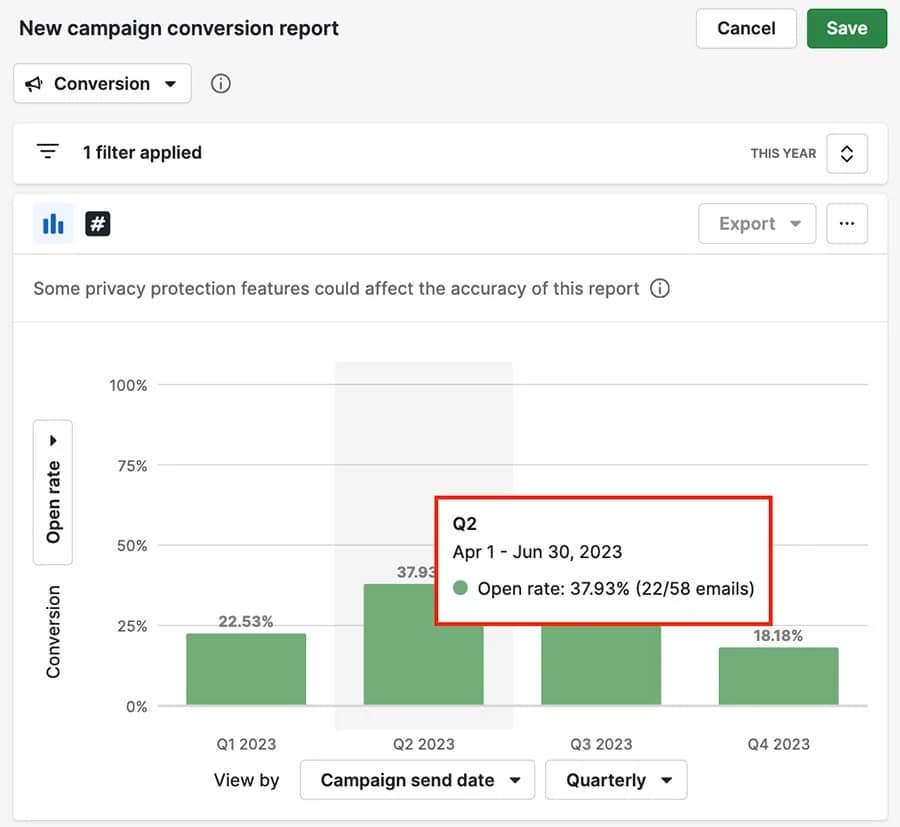
In this example, you could highlight an increase in email open rates (the Y-axis conversion metric) to demonstrate customer interest in a new product feature, assuming that feature appeared in the email subject line.
Tips to summarize your findings:
-
Use visuals to aid your storytelling and support your argument. Your CRM, for example, can generate graphics using internal data.
-
Process your findings to help you draw actionable takeaways that benefit your small business
Step 6: review your report and findings
Review your report and findings before sending it to colleagues and stakeholders. Ensure it makes sense and answers the objectives you chose at the start of the process.
Tips to review your findings:
-
Leave at least a day before proofreading your report and read through it multiple times
-
Focus on your argument on the first pass before moving on to spelling, grammar and other more technical aspects
-
Use tools like Grammarly and Hemingway to catch grammatical errors and improve clarity
What should you include in your market research report?
A market research report template is always a helpful jumping-off point. Alongside it, remember to include the following essential elements.
An executive summary
An executive summary is a concise roundup that helps time-restricted stakeholders to quickly understand your key findings.
Make your summary short and engaging. It will rarely be the only thing people read, but it should briefly summarize your arguments if it is.
A good executive summary can also set the course for the rest of the document, hinting at the argument you will make.
The healthcare-focused executive summary below from the Boston Consulting Group gives readers a brief overview of the arguments in the report.
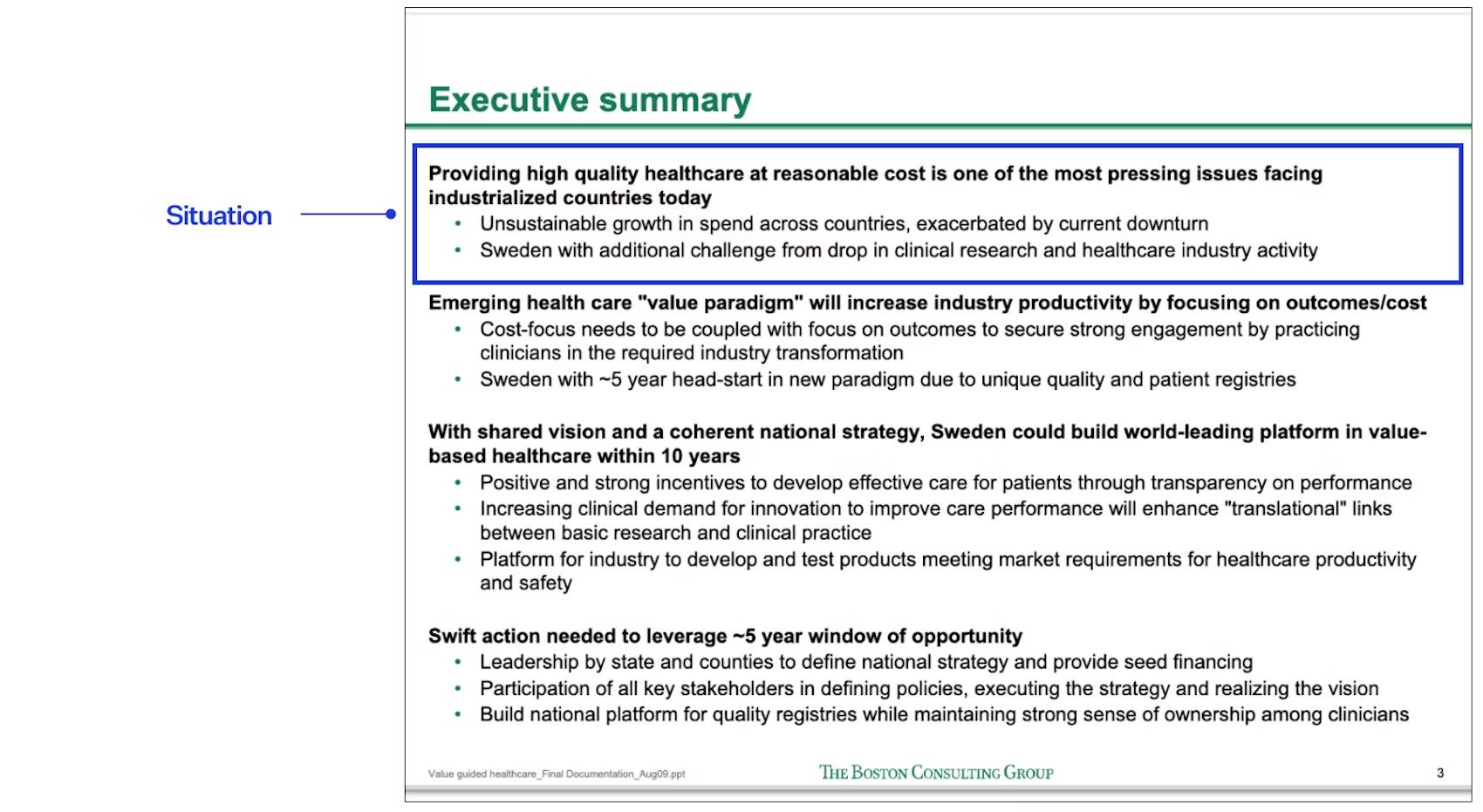
An explanation of your research methods
Detailing your research methods gives context to your findings and highlights any limitations stakeholders should consider when implementing your suggestions.
Be specific here. Rather than mention you conducted a survey with customers, specify the number of customers you spoke to, detail each customer’s seniority or buying power and list the questions you asked. You want to prove your takeaways are based on the opinions of relevant buyers.
Examples to support your points
Great market research reports show rather than tell. Support your argument with customer examples, graphs or other visuals that allow readers to draw their own conclusions.
If you find that customers feel a certain way about a new product, include one or two quotes from a focus group demonstrating this attitude. Another strategy is to turn quantitative research (like the brand rankings mentioned earlier) into a chart or graph, like this illustrative visual in the McKinsey report on MSMEs:
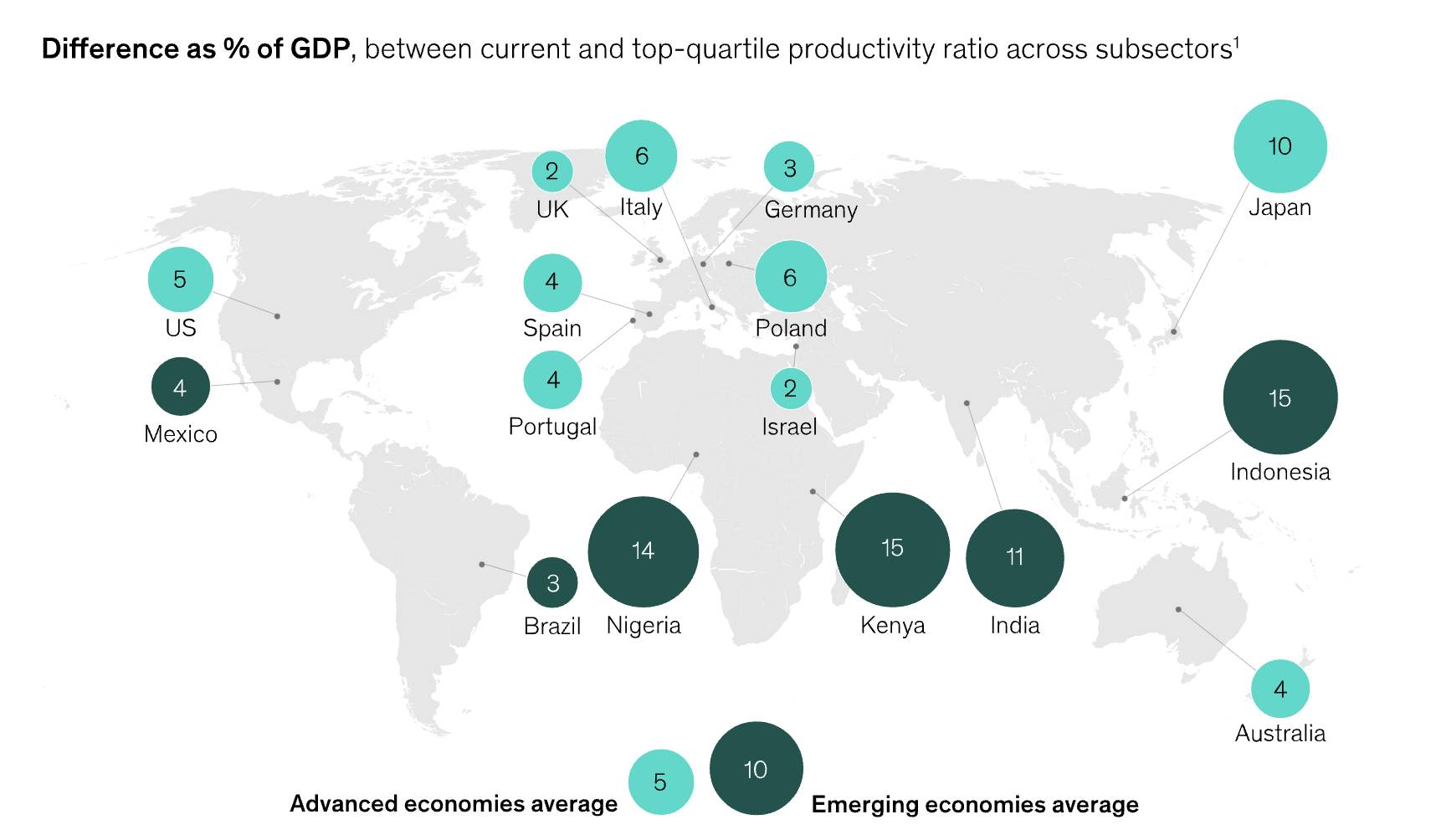
End with takeaways
End your market research report with a takeaway section summarizing your key findings and recommendations. The goal is to make it as easy for colleagues and stakeholders to make decisions based on your research.
As such, ensure any takeaways are actionable and relate directly to the objectives you outlined at the start of the report.
If your goal was to test the viability of a new product, summarize consumer sentiment and outline how to proceed. That could be a go-to-market strategy if the opinion was favorable or a specific recommendation on how to improve the product if it wasn’t.
The state of sales and marketing 2024
Discover key statistics about sales and marketing
4 best practices for writing insightful customer research reports
Take your market research report from good to great by implementing the following best practices.
1. Be concise
Your research can (and should) be as detailed as you wish, but keep your report digestible for stakeholders or partners. While senior employees will welcome your hard work, they may not have time to read through a 50-page report.
There are several ways to keep your report on target:
-
Practice brevity. Only give the reader essential information. You don’t need to support your argument with dozens of examples – one or two will suffice.
-
Simplify your language. Avoid technical terms or industry jargon unless you’re speaking to knowledgeable readers. Don’t assume all your board members will understand.
-
Keep your structure. A logical flow will keep you on track and help you move swiftly from one point to the next.
Recommended reading

48 essential sales terms that all salespeople and marketers should know
2. Tell a compelling story
Make your report memorable with a compellingly crafted story. Readers remember what they learn from stories, even if the story is a market research report.
You can create a narrative by:
-
Knowing your audience. Write with their goals in mind using an appropriate tone of voice.
-
Setting the scene. Outline the problem you’re going to solve. Refer to it frequently in your writing.
-
Using the active voice. It’s more direct and engaging.
3. Use images or other visuals as much as possible
Rather than confront readers with walls of text, use images, graphs and other visuals to deliver a more palatable reading experience.
These features will not only make your report more approachable but also improve your storytelling and support your arguments.
Even small icons and pull quotes like those in the report excerpt below are enough:
Keep in mind these tips when adding images to your report:
-
Use the right graph for the right data. Ensure your visual represents the data accurately and reports the information clearly.
-
Use annotations. Annotate graphs with snippets explaining what the data shows so it’s quick and easy to understand.
-
Keep file sizes manageable. Large images will slow down your presentation and bulk up your documents. Keep image sizes as minimal as possible without reducing the quality.
4. Use an appendix
While stakeholders may only have time to skim your research, others may devour it in full. Allow them to do so with an appendix that details all your findings.
A McKinsey report on generative AI ends with nine pages that outline the scope, objectives and relevant study overviews like this one:
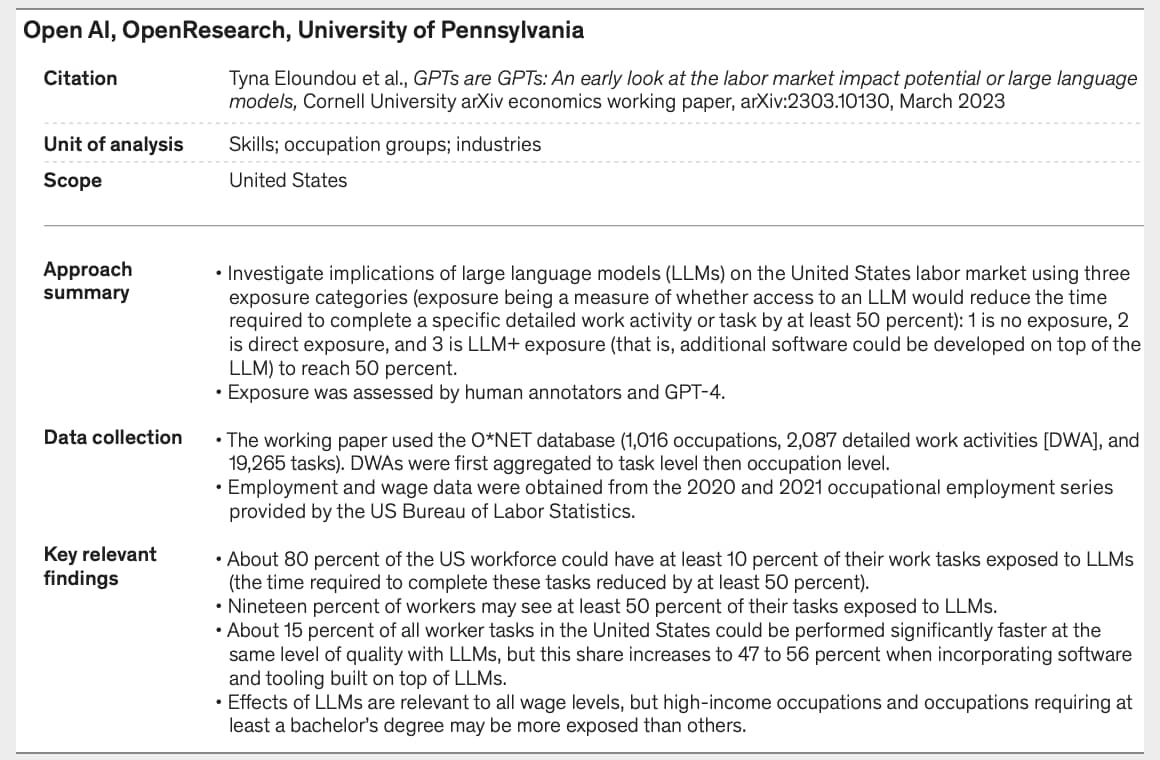
Add footnotes and references to the main part of your presentation to make your appendix more usable, meaning those who want additional detail can quickly refer to the back of your document.
You can streamline your appendix by:
-
Labeling it clearly. If your report is long, you can separate your appendix into different sections, such as by charts and images.
-
Ordering the information. Ensure your appendix follows the report layout and sequencing. Even if you have multiple sections, your first graph could be the first in Appendix A and the first image could be the first in Appendix B.
Final thoughts
Whether you want to understand a new niche or get feedback on a new product for your small business, your market research report can help stakeholders across your organization to take informed and purposeful action.
Make things as easy as possible for yourself by leaning on the tools you already have at your disposal. Your CRM, for example, can unearth suitable research prospects, support your outreach efforts and even create graphics for your reports.
If Pipedrive is of interest and you'd like more information, please do make contact or take a look in more detail here.
Credit: Original article published here.
